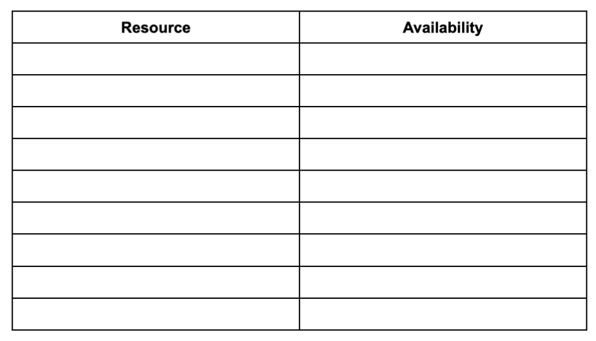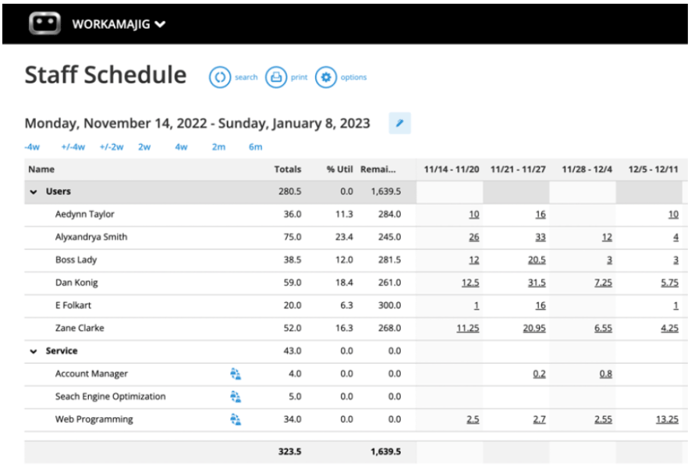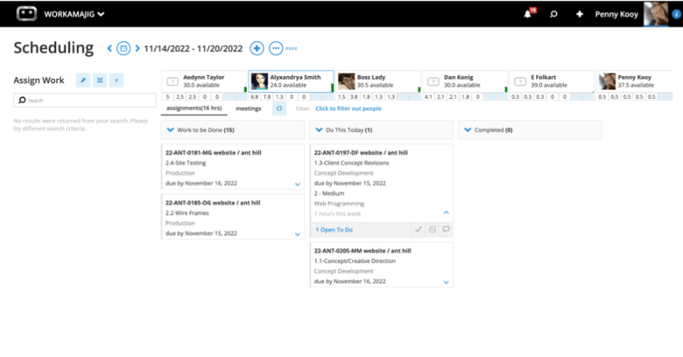Imagine this: You're an elementary school teacher and it’s the first day of school. You’ve got 3 piles of workbooks to give out and boxes of pencils, glue sticks, and scissors. How do you go about giving them out?
Call each child to your desk one at a time to collect their pencil and then repeat for every item?
Choose one capable-looking child to give everything out to everybody?
Both ideas are pretty foolish, not to mention downright inefficient.
Though usually more complicated in nature, project resourcing is only as efficient as the person and processes in charge of it.
What is allocation of resources?
Resource allocation definition: the process of arranging resources in the most efficient way possible so that the right resources are available at the right times.
In project management, this translates into coordinating projects and resources so that there are enough of the required resources for the duration of a project. It also prevents over-allocation or under-allocation of resources, as well as ensures that employees are suited to and happy with the tasks they are being allocated.
What is considered a resource?
Resources include everything needed to complete a project, such as:
- People
- Money
- Time
- Equipment
- Office space/outdoor space
- Hardware/software
What are the benefits of resource allocation?
-
Maximizes efficiency: when resources are thought out and allocated wisely, projects can be completed with minimal hiccoughs or delays.
-
Increases bottom line: When projects are completed efficiently, more projects can be taken on, so more profit is made. Efficient project management resource allocation also keeps your agency's costs down, e.g. you won’t be paying employees to sit idly at their desks.
-
Improves client satisfaction: All clients enjoy working with agencies that complete projects before the deadline, which ultimately adds to the bottom line. The more satisfied your clients are, the more likely they are to ask for more projects.
-
Boosts team morale: Good resource allocation planning means that no one has too much or too little on their plate and that tasks are paired with the most suitable people for the job. When employees have just enough of the right amount of work, morale is guaranteed to improve.
-
Improves collaboration: When resources are well allocated, team members know what their responsibilities are and what their colleague's responsibilities are, making your team a collaborative unit.
How are resources allocated?
-
Define project scope: To know what resources are required for a project, you first need to know what exactly the project entails. A scope statement comes in handy at this point - a document that details exactly what the project entails.
-
Work out your resource availability: Before you can allocate your resources, you need to know what resources you have available.
-
Record all resources into a table/software: By having all available resources recorded in one place, you’ll be able to designate resources most efficiently, as well as track when resources increase/decrease. Having different resources recorded and tracked in different places is cumbersome and makes it extremely difficult to allocate resources effectively.
-
Match tasks with people: One of the best ways you can effectively allocate your resources is to allocate tasks to the people who are best at them and enjoy them most. That way, tasks will be completed quickly and employees will be happy.
-
Don’t over or under-allocate: Back to our elementary school teacher; imagine the teacher would give every child five pencils, three glue sticks, and two pairs of scissors. Most of those resources would probably get lost before the first week of school is over.
But, if the teacher would give out only one workbook between two, and one glue stick between four, the class would struggle to get any work done and end up far behind. Same with project management: allocate too many resources to a project, and it’s a waste, allocate too little and the project will not be of good quality and likely miss the deadline. If we’re talking about people as resources, it’s also important not to over or under-stretch your employees. -
Make expectations clear: The best resource allocation plan will only be as effective as how well your team understands it. By ensuring that each team member knows what is required of them and which resources they have at their disposal, you ensure that each resource is used to its maximum.
-
Track resources and reallocate when necessary: Once your project is off the ground, it’s unlikely that everything will stay status quo. Instead, you’ll likely be faced with unexpected shortages and surpluses of resources. It’s therefore imperative to keep your finger on the pulse and reallocate resources as the project goes along.
-
Know your budget and track it: A fundamental resource to keep track of is the project budget, as it will determine the availability of other resources. The best way to keep tabs on your budget is with resource management software that can update you in real time about where and how your budget is being used.
-
Track time: Strategic resource allocation includes tracking time. Then, at the end of the project, you can see how long various tasks took and use that information to allocate resources realistically for the next project.
-
Minimize scope creep: Although scope change is pretty much inevitable, you can take control of how badly it affects resources by planning ahead with a change management plan. A change management plan is set before a project begins and determines how the agency will deal with a scope change request.
-
Put someone in charge: Make someone responsible for allocating resources and staying on top of them. Without that, it’s easy for everyone to assume that someone else is in charge and then your careful plan goes out the window.
Read more: 10 Steps to Optimize Resources in Project Management
Resource allocation examples
We’ll base our example of resource allocation around an ad campaign project, and discuss how to allocate the necessary resources.
First, we’ll define what’s included in the project, which in this case, is a series of print and TV ads.
Then, we figure out what resources we have available and plug them into a resource management software (which would probably be Workamajig being that it’s the best one;))
Now, we designate, making sure every team member gets the right amount of work, not too much or too little. We also ensure that we’re matching tasks to the people who are best at them. So the print ads go to James, who has 3 years of experience in print ads and enjoys creating them, and we task Amanda with the TV ads because her greatest joy is seeing the ads she created appearing on TV.
Once the project is off and running, we track, track, track. Track where the resources are going, track the budget and track team members' time.
Tim is put in charge of monitoring resources because he has the head and organizational skills required and we minimize scope creep by processing any change request through a predetermined change management plan.
And…guess what happens?
The project fails miserably!
Why? Did you notice what stage we forgot?
We merrily allocated tasks to James, Amanda, and Tim, but failed to tell them about it - no go!
Next time, we’ll remember to clearly inform team members of their tasks and document tasks and progress in a place that can be easily accessed.
Resource allocation template
Use the basic template below to start effectively allocating resources.

How can Workamajig help you allocate resources like a pro?
As the only resource management software created specifically for creative teams, Workamajig’s intuitive resource management capabilities help you pull off successful projects without hiccups or headaches. Here’s how:
- Easily see what's needed & assign work in just a few clicks from the project schedule.
- Get ahead of the game with our ready-to-go templates - or customize your own - that include typical resources needed for each project type.
- Have everything you need at your fingertips. View workloads by week or day for the whole team, & filter by office, department, role, service, or person.
- Plan proactively, not reactively. View real-life utilization, including meetings, vacations, company holidays & job commitments.

Get the updates you need, in real-time
Know exactly where you stand with updates that factor in assigned work, task updates, and schedule changes.
- Get the bigger picture with less manual work. Easily view, filter, sort, & group all tasks (current, future, assigned, or unassigned)
- Resourcing that stays connected to related projects lets you make quick changes & get instant recalculations
- Color-coded views factor in vacations, company holidays, and overbooked schedules to show you exactly where you need to focus
Keep your team happy & engaged
See your creatives' daily schedules (& meetings) just like they do, & easily rebalance work for the week - or month.

- New tasks show up automatically on your creatives' daily task lists, with full context.
- Managing priorities with drag & drop ensures tasks that need attention get it.
- De-stress resourcing surprises. Is someone out or sick? Reassign their tasks with ease.
Related reads:
- 5 Steps to Creative Project Planning
- Creative Workflow Management: Best Practices + Software Tools
- 10 Top-Rated Project Management Tools
Originally published 3/29/23.


